| |
FIVE DECADES OF
AMELIA PELÁEZ
1920s to the 1960s |
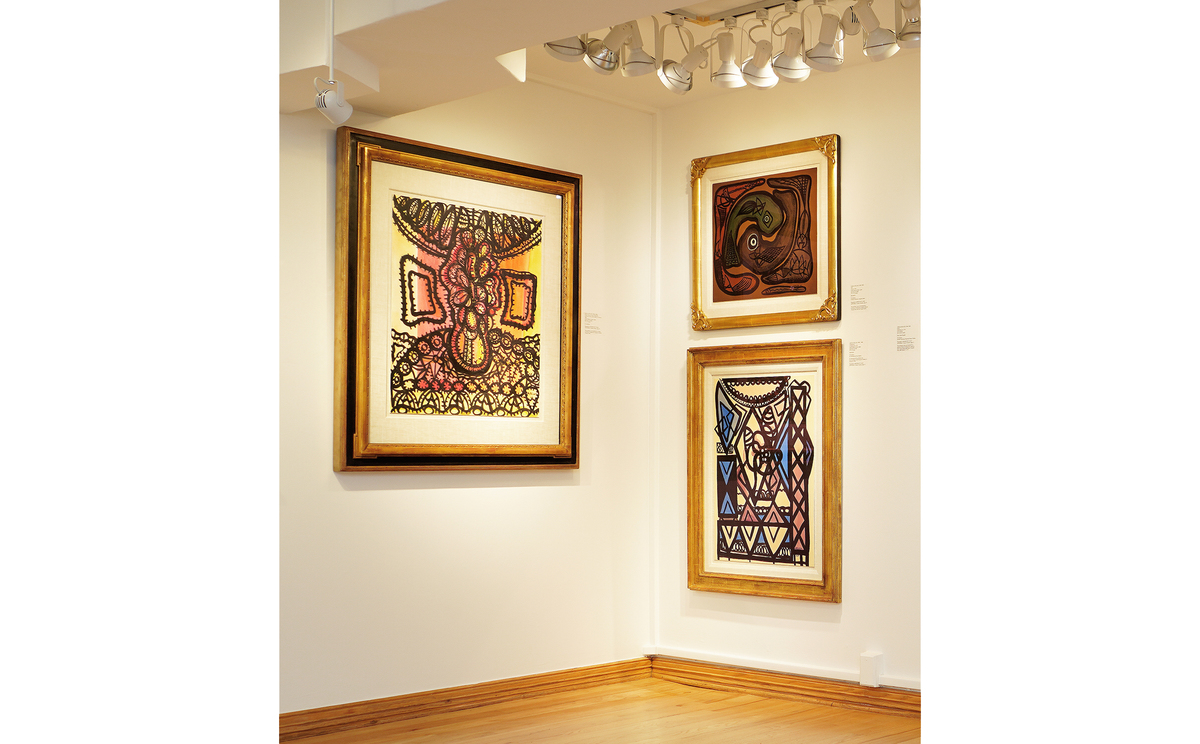 |
FIVE DECADES OF AMELIA PELÁEZ 1920s to the 1960s
Considered a grand master of modern Cuban art, and a seminal figure in 20th century Latin American painting, Amelia Pelaéz is one of the most acclaimed artists of her times.
Her contribution to the avant-garde women’s movement in the arts- internationally speaking- was a palmary achievement.
Just like Frida Kahlo in Mexico and Tarsila do Amaral in Brazil, Amelia -with her strong artistic voice- was able to break through the male dominant avant-garde movement of the era, eventually becoming a pioneer of Modernism in Cuba. An extraordinary exhibition that exalted Amelia’s stardom as one of the leading modern masters of Latin American art was the 1997 traveling show entitled, Tarsila, Frida y Amelia at the Centre Cultural de la Fundación “la Caixa” in Madrid and Barcelona, Spain.
The artist was first trained in and graduated from San Alejandro Academy in Havana under the academic mindset that prevailed in this art school. There, she excelled in painting, drawing, ceramics and muralism.
In 1924, the artist went on to travel to New York where she studied at The Arts Student League. Later on, in 1927, she traveled to Europe, visited Spain, Italy, and lived in Paris until 1934. It was in the City of Light where Amelia absorbed the European avant-garde movements. Matisse, Leger, Picasso, Braque and Gris, among others, shaped her imagery. European trends as Cubism, Fauvism and the Russian Avant Garde aided in enriching the traditional instruction she had received in San Alejandro. It was then that Amelia began to forge her own artistic vocabulary, marked with her superb force and sensibility.
While in Paris, she studied at the Academié de la Grande Chaumière, and later entered the École Supérieure des Beaux-Arts, and the École du Louvre. To broaden her knowledge, she visited an array of museums, mingled with the social artistic circles of the city, and became a close friend of the Cuban writer and intellectual, Lydia Cabrera who at that time was also living in Paris. Her studies in design and color theory with Russian avant-garde artist, Alexandra Exter (from 1931 to 1934) expanded the development of her formal training and awakened her interest in Cubism.
Peláez earned her peers’ admiration in Europe with her first Parisian solo show in 1933 at the prestigious Galerie Zak, which at the time was a most important venue for contemporary art exhibitions -staging works by Chagall, Picasso, Modigliani and Gris, among others. To exhibit at Galerie Zak implied a level of recognition that elevated Amelia in the eyes of the arts community.
In 1934, Amelia returned to Cuba at the age of 37. She then joined the active cultural circles in the island. A year later, the artist showcased her European works at the Lyceum, an important forum for female painters.
In Havana, the artist established her studio in her beloved home in La Víbora district and worked with quiet determination. During the 1940s, Amelia perfected her craft and grounded her signature cubist style. The artistic circles in Cuba were much captivated by her work, which was featured and lauded in various solo and group exhibitions where she garnered several salon prizes. She was one of the few women who were selected to participate in the important Art in Cuba show at the University of Havana in 1940. Her first retrospective took place at the Institución Hispano-Cubana de Cultura in 1943. By this time, Amelia played a vital role as a key disseminator of a new national culture that engaged not only with the island’s emerging modern art scene, but also, with the broader international narratives of modernity.
Moreover, in 1944, Amelia was one of the 13 artists included in the ground breaking exhibition, Modern Cuban Painters at MoMa (the Museum of Modern Art in New York), curated by Alfred Barr. The exhibition, which showcased Cuban art as a highlight of the contemporary art world for the first time, presented 11 works of the artist. The show then traveled to twelve museums across the United States including, the National Gallery in Washington D.C. and the San Francisco Museum of Modern Art.
The depiction of the artist’s heritage - in a resolutely modern style - is most important in her body of work. Thus the viewer can appreciate in her compositions how she synthesized avant-garde aesthetics with the Cuban motifs of her intimate surroundings: gardens, tropical fruits, flowers, birds, ceramic vases, bowls, dishes, lace tablecloths, hand-crafted furnishing and colonial architecture subjects, including, ironwork, stained glass windows, wicker chairs, ornate columns and balconies. Her free-flowing bold black lines, which outline areas of intense color, evoke Cuba’s baroque architecture of that era.
Amelia Pelaez’s legacy asserts the significant role she played at the genesis of modern art in the Americas and how she, together with other artists of the epoque, helped shape the global trajectory of modernism.
Nercys Cernuda
|
|
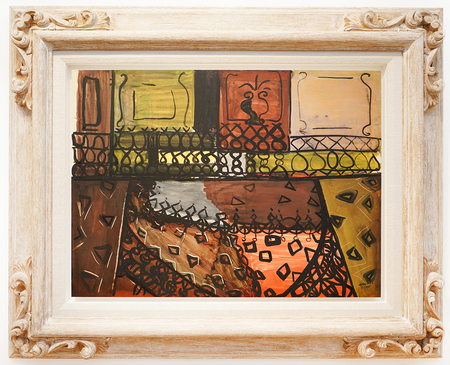 |
Amelia Peláez
Interior with Balcony
(Interior con Balcón), 1947
mixed media on heavy paper laid down on board
22 x 30 inches
Exhibited in Amelia Peláez: The Craft of Modernity, at the Pérez Art Museum, Miami, FL, Dec. 4, 2013 to Feb. 23, 2014,
and illustrated in the corresponding catalog, page 91.
Exhibited in Cuban Art in the 20th Century: Cultural Identity and the International Avant Garde, at the Florida State University
Museum of Fine Arts Tallahassee, FL, Feb. 12 – Mar. 27, 2016; illustrated on the cover and on page 81 of the accompanying catalog. An exhibition which later travelled to the Coral Gables Museum, January 22 – April 23, 2017.
Illustrated in Important Cuban Artworks Volume Seventeen,
Cernuda Arte, Coral Gables, Florida, 2019, page 20.
In the most insightful analysis of [Amelia] Peláez’s stylistic sources in Cuban architectural decoration, artist Robert
Altmann introduced the issue: “The paintings of Amelia Peláez are a conscious vision of the dominant role of ornament in relation to the theme of still life and of the elements of Cuban ornamental art of the last century.”(1) “In her own studio,” he observed, “Amelia Peláez accumulates vestiges of the colonial past: corinthian columns,
mamparas, sculpted chairs, and other objects that remind her at every glance of a precise stylistic language [that of Cuban nineteenth-century ornamental art].”(2) About the specific connections between her style and the precise visual language of colonial architectural decoration, Altmann was one of the first to point out that her use of color and chiaroscuro suggests the filtration of light created by the medio punto, and that her linear arabesques construct a limited, static space defined by perforated screens parallel to the picture plane, not unlike the space found in traditional Cuban ornamental iron and wood works. He concluded that Peláez’s paintings were a carryover and a rehabilitation of forgotten ornamental tradition found in Cuban nineteenth and early-twentieth-century architecture and crafts.
(1)(2)Robert Altmann, “Ornamento y Naturaleza Muerta en la Pintura de Amelia Peláez”, Orígenes, La Habana, No. 8, Invierno, 1945.
Juan A. Martínez, Cuban Art and National Identity, The Vanguardia Painters,
University Press of Florida, 1994, page 133.
|
|
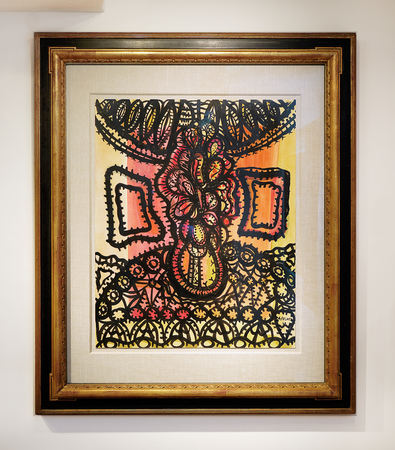 |
Amelia Peláez
Flower Vase on a Lace Tablecloth
(Jarrón de Flores sobre Mantel de Encaje), 1960
mixed media on heavy paper laid down on board
31 x 25 inches
This painting is accompanied by a photo-certificate of authenticity
signed by Ramón Vázquez Díaz.
Illustrated in Important Cuban Artworks Volume Fifteen,
Cernuda Arte, Coral Gables, Florida, 2017, page 39.
|
|
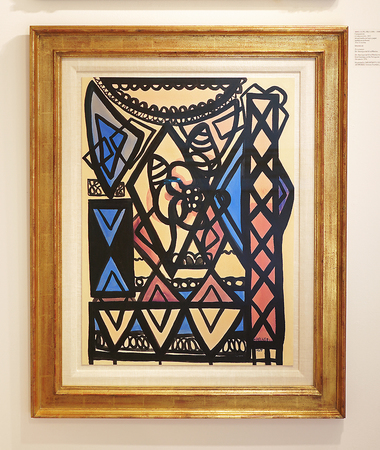 |
Amelia Peláez
Composition
(Composición), 1955
mixed media on heavy paper laid down on board
30 x 22 inches
Provenance: Dr. Henrique da Silva Martins.
Dr. Henrique da Silva Martins was First Secretary at the Portuguese Embassy in Havana in 1958.
Illustrated in Important Cuban Artworks Volume Fourteen,
Cernuda Arte, Coral Gables, Florida, 2016, page 25.
|
|
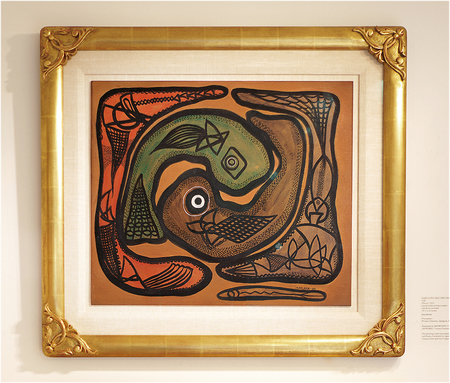 |
Amelia Peláez
Fish
(Peces), 1955
mixed media on heavy paper laid down on board
19 3/4 x 23 inches
Provenance: Private Collection, Zaragoza, Spain.
This painting is also accompanied by a certificate of authenticity
signed by Ramón Vázquez Díaz and José Veigas Zamora.
Illustrated in Important Cuban Artworks Volume Fourteen,
Cernuda Arte, Coral Gables, Florida, 2016, page 26.
|
|
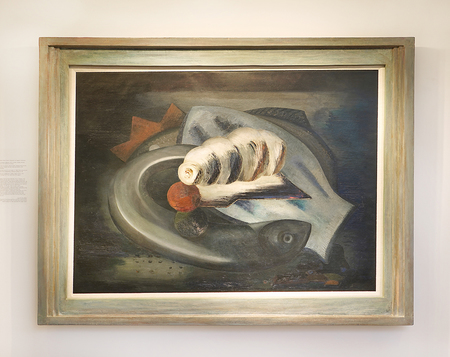 |
Amelia Peláez
Grey Fish
(Pescados Grises), 1931
oil on canvas
38 x 51 inches
Provenance: Luis Amado Blanco Collection, Havana, Cuba;
Private Collection, Los Angeles, California.
Exhibited in Amelia Peláez del Casal, January-February 1935, Lyceum, Vedado, Havana, Cuba, and listed no. 19 (Pescado Gris) in the exhibition brochure.
Exhibited in Exposición de Pintura, Víctor M. García, Amelia Peláez, Domingo Ravenet and Carlos Enríquez, August 8, 1936, Lyceum, Vedado, Havana, Cuba, and listed no. XII (Pescados Grises) in the exhibition brochure.
Exhibited in Amelia Peláez, Exposición Retrospectiva, November 14, 1968, Museo Nacional de Bellas Artes, Havana, Cuba, and listed in the corresponding exhibition catalog, no. 58.
Illustrated in Diálogos Constructivistas en la Vanguardia Cubana: Amelia Peláez, Loló Soldevilla and Zilia Sánchez, Galerie Lelong, New York, April-June 2016, page 6.
Illustrated in Important Cuban Artworks Volume Fourteen, Cernuda Arte, Coral Gables, Florida, 2016, page 22.
[Amelia] “Peláez studied with [Alexandra] Exter in Paris from May 1931 to January 1934, shortly before her
return to Havana. During this time they worked in collage, studied book illustration, created set designs, and
explored still life. Peláez reported that she owed Exter ‘her greatest advancement and technical understanding.’
Indeed Exter’s experimental interpretation of Cubism and Futurism, animated by the dynamic potential of color,
appears to have inspired Peláez’s approach to a lifetime of painting, even after her return to Cuba [1934]…
Exter’s strategy of centering the composition on a weighty object around which swirled ‘whirlwinds of geometric
forms,’ often spinning off planes, influenced Tatlin’s Monument to the Third International (1919-1920), a work
foundational to Russian Constructivism.
Peláez also adopts Exter’s interest in movement around a central pivot point in her circa 1931-35 Pescados Grises
(Grey Fish). In their case a stylized, flattened fish and still life object become the focal point for the curved body
of another, nearly-living black fish that wraps around them. This subtle movement may be the beginning of the
black arabesque that would become the hallmark of Peláez’s mature style…”
Ingrid W. Elliot, Ph.D., excerpt from the catalog essay
Between the Real and the Invisible,
Diálogos Constructivistas en la Vanguardia Cubana: Amelia Peláez,
Loló Soldevilla and Zilia Sánchez,
Galerie Lelong, New York, April-June 2016, pages 5 and 6.
|
|
 |
Amelia Peláez
Table Cloth
(Mantel), 1930
mixed media on heavy paper laid down on board
17 ¼ x 10 7/8 inches
Provenance:
Collection of Guido Adriaenssens, Commercial Attaché to the Belgian Embassy
in Havana in the early 1980s. He acquired the work from Carmen Peláez,
sister of the artist. We are grateful to Carmen Peláez for having confirmed
the provenance and authenticity of this work.
|
|
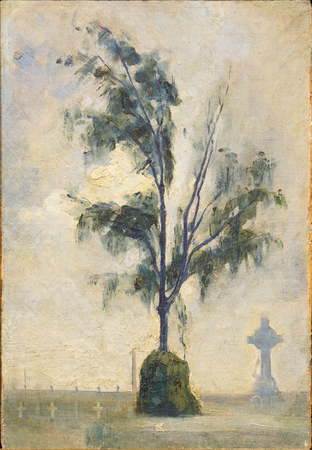 |
Amelia Peláez
The Tree and the Cross
(El Árbol y la Cruz), ca. 1925
oil on canvas board
12 1/2 x 8 1/2 inches
This artwork is accompanied by a certificate of authenticity issued by Ramón Vázquez Díaz, dated November 20, 2006.
Illustrated in Important Cuban Artworks Volume Six,
Cernuda Arte, Coral Gables, Florida, page 20.
|
|
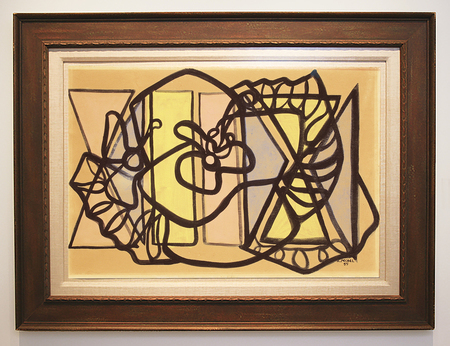 |
Amelia Peláez
Stained Glass with Hibiscus
(Vitral con Marpacíficos), 1955
mixed media on heavy paper
19 x 29 inches
This painting has been part of the collection of Bernardo Viera Trejos, who acquired it directly from the artist.
Illustrated in Important Cuban Artworks Volume Seven,
Cernuda Arte, Coral Gables, Florida, page 28.
|
|
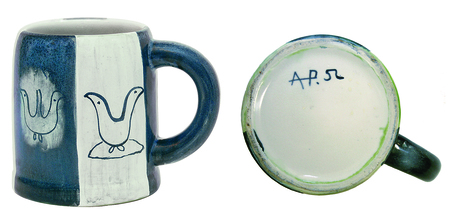 |
Amelia Peláez
Mug
(Jarra), 1952
one-of-a-kind, hand painted ceramic
3 3/4 x 5 x 4 inches
Signed ‘AP 52’ on the bottom
This ceramic work by Amelia Peláez comes from the Dr. Adalberto Quintana Collection, Havana, Cuba and San José, Costa Rica.
Dr. Quintana was the personal physician of Carmen Peláez and received these ceramics
directly from the sister of the artist.
Illustrated in Important Cuban Artworks Volume Twelve,
Cernuda Arte, Coral Gables, Florida, 2014, page 19.
|
|
|
| |
| |
| |
| Copyright 2002-2025, Cernuda Arte. All Rights Reserved |
| |
|
| |
